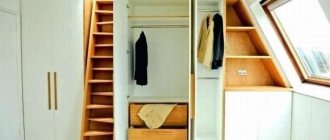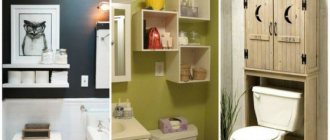A well-designed and high-quality attic wardrobe provides the opportunity for rational use of attic space. The article talks about the complexity of installation, design features and structures of attic cabinets. The proposed material contains information about the advantages of cabinet and built-in furniture, types of door facades and their design, and offers recommendations for selection.
Built-in wardrobe in the bedroom interior Source remont-samomy.ru
About the difficulties of furnishing an attic
It is not for nothing that the attic is considered the most unusual room, the highlight of the house. Whatever you plan to arrange in it - a bedroom, an office, a nursery or a library, the original outlines will make the room cozy and romantic. However, there are pitfalls along the way of arranging an attic. A typically small space with a tapering ceiling and sloping walls can cause a lot of trouble in the furnishing process.
Great difficulties arise when choosing a suitable cabinet - it is useless to look for a ready-made model on sale with parameters that match the shape of your attic. The problem is solved in different ways. Sometimes (if the room is large enough), inclined structural elements are covered with plasterboard and you get an ordinary room with the correct geometry. If the room is small, such an operation will turn it into a storage room for unnecessary things. If you like the complex geometry of space, you can go another, more rational route; Using built-in wardrobes will help preserve the uniqueness of the attic and benefit from it.
Non-standard option Source pinterest.nz
Tips for arranging a dressing room in the attic
A dressing room in an attic room is created taking into account the following useful tips:
- First you need to create a project with a detailed designation of each element and dimensions.
- Space should not be abused. The structure should be spacious, but at the same time compact.
- If the second tier of the house has a sloping wall, then this is an ideal place to place clothing storage items.
- If you need cabinet cabinets, you should purchase models with sliding doors. Swing structures will significantly reduce usable space.
Important!
It is imperative to take care to protect things from moisture and moths. To do this, the walls of the second tier are insulated and covered with a waterproofing layer. The same should be done for the roof to avoid leaks during rainfall.
The attic space opens up the opportunity for the owner to create a convenient and high-quality place to store clothes. After reading this article, you can make good use of the space on the top floor and provide yourself with a spacious dressing room.
Features of designing cabinets for the attic
When designing a closet for an ordinary room, it is enough to know the dimensions of the room. Designing a cabinet for an attic with a sloping roof is complicated due to the characteristics of the attic space, the configuration of which may have the following features:
- Sloping ceilings (with varying heights) and walls with projections.
- Non-standard window placement.
- Protruding support and load-bearing beams.
- Non-standard attic geometry : turned corners and rounded areas.
The attic space needs and can be used functionally; Cabinets can be of great help in this regard. Properly designed furniture of high quality allows you to use the space with maximum benefit.
Stylish office in the attic Source pinterest.co.uk
When creating a project (regardless of what needs the attic is equipped for), do not forget about some important points:
- Attic accent . In most cases, the closet is the largest and therefore the central element of the decor; At the same time, both its appearance and functionality are important. The design of any design must take into account the needs of the owners, fit into the interior and save space.
- Lighting . Natural sunlight in the attic is part of its charm. Therefore, when choosing materials for a cabinet under an attic roof, you should give preference to light options that will not create the impression of a bulky object that absorbs precious meters.
- Disguise . If the wall has an unevenness (slope), the built-in structure will help hide it. The top line of the cabinet, repeating the slope of the ceiling, will emphasize the uniqueness of the attic space and create the impression of completeness of the decor.
Children's room in the attic Source pinterest.com
Storage system and space organization
A dressing room in the attic should be spacious, but at the same time provide ergonomics without taking up all the usable space. The combination of functionality and convenience can be provided by the following structural systems.
Panel system
It is named so because all elements are mounted relative to one wall. The wall becomes a single frame for hangers, stands and panels.
Important!
At this time, these are the most expensive systems among other wardrobe equipment.
Hull
Open cabinet shelves, massive stands and remote hangers are mounted to a straight or inclined wall. This allows you to significantly increase capacity, but at the same time makes access to things located in the recesses of the cases somewhat difficult.
Frame
The frame dressing room on the attic floor has a modern look and functional completeness. External frames are mounted on the wall, on which shelves for shoes and clothes hangers are fixed. The frame allows easy access to things and placement without crowding.
Types of cabinet designs
The choice of location for the attic closet is influenced by the relative position of the windows and doors, the arrangement of other furniture and the overall design idea. The easiest way to determine a suitable position is by measuring, taking into account the selected cabinet design, which can be one of three types:
- Cabinet (frame). The shape of the cabinet exactly follows the geometry of the walls and ceiling slope. This piece of furniture has a back and side walls.
- Built-in (with false frame). Shelves are installed in the chosen location, which are then covered with a façade or left open, as you like.
- Dressing rooms . A current type of attic arrangement that allows you to comfortably place clothes and shoes. The dressing room can be the size of a spacious closet, or it can occupy a significant part of the attic space, becoming a separate room.
Built-in wardrobe with a mirror facade Source yandex.com
See also: Catalog of companies that specialize in house design.
In order for the built-in wardrobe in the attic to serve its owners properly, special attention is paid to the proper arrangement of doors. Sloping ceilings, which give the room an elegant look, at the same time create problems not only when arranging, but also during the use of furniture, if this is not taken care of in advance. Cabinets intended for use in the attic are equipped with the following types of doors:
- standard swing ;
- folding (tram accordion doors);
- compartment door.
Furniture with hinged doors is considered unsuitable for an attic room. Such door facades can rarely open completely - in a certain place the moving door will rest against the slope of the ceiling. Another option is common when the ceiling does not interfere, but an open door will not allow you to use the area in front of the cabinet more efficiently. It is also not always possible to improve the situation by rearranging the furniture.
Symmetrical wardrobe Source pinterest.ca
See also: Catalog of projects of houses with an attic presented at the exhibition “Low-Rise Country”.
Considering such inconveniences, it seems right to choose models with folding or beveled swing doors, or a more common type - a sliding wardrobe. Popular solutions for attic cabinets under slopes are as follows:
- Wardrobe design . The standard design is equipped with rollers sliding along guides. The beveled design is equipped with an additional set of guides and rollers.
- Design of a hinged attic wardrobe . It differs from the usual one in the way the hinges are hung - they are secured so that the beveled sash opens freely.
- Combination _ Sometimes the design combines both options - a swing system and a straight wardrobe.
Women's area design
Women's areas are more massive and functional. Case systems allow you to achieve a combination of large area and functionality. Women find the upper or middle position for shoes very convenient, when everything is in sight and the choice is not difficult. At the same time, outerwear should also be publicly available.
Important!
For women, the storage area should be provided with ottomans for convenience and a large illuminated mirror - therefore they are located in close proximity to the windows. In addition, special places for storing jewelry and other accessories are extremely important for the fairer sex.
Cabinet shape
For attics it is necessary to make structures of various shapes; the most popular include:
- Cabinet furniture . Common types: linear sliding wardrobes, radius (concave and convex), corner models (L-shaped), trapezoidal (symmetrical and asymmetrical). Such products are inferior to their built-in counterparts in terms of capacity and ease of use.
- Built in furniture . The popular ones include both a trapezoidal model (with two bevels in the upper part) and models with one bevel, or angular. The door leaves follow the shape of the structure - the side facades have bevels.
Built-in model Source pinterest.com
Types of structures for the attic
What cabinets can be placed in the attic so that free space is wasted to a minimum and so that the functionality of the furniture does not suffer?
Location options
How to arrange furniture in the attic so that its operation is convenient?
Peculiarities
The peculiarity of built-in furniture for the attic is obvious - it is the beveled shape of the facade
Cabinets installed in the attic have one distinctive feature - beveled doors. This feature allows you to fit furniture into the attic space, rationally using the space.
However, this feature complicates the door design. Therefore, some cabinet models are turned with the back wall towards the slope and in this case only rectangular doors are used. In other cases, to simplify the installation, inclined sliding doors are replaced with swing doors that are easier to install.
Door opening mechanisms
How does the sliding door mechanism work if the outer doors in the structure have a beveled upper part?
Upper guide profile along which the roller door hanger moves horizontally
Rectangular doors located along the edge move as usual, that is, relative to each other. Hanging rollers are installed on top of the sash, which are fixed on the guide rail. Support rollers are installed in the lower part of the structure, which move along the lower profile.
Diagram of the device of the beveled sash: 1) inclined frame strip, 2) vertical strips, 2) bottom strip, 4, lower rollers, 5) guide profile, 6 and 7) connecting pins
Article on the topic: Do-it-yourself wardrobe staircase
The situation is somewhat more complicated with beveled sashes. Since the upper part is beveled, that is, triangular, it will not be possible to use hanging rollers on it. How is this problem solved?
Installation diagram of rails and leash for a beveled compartment door to the attic
Diagram of a sliding facade
The proposed drawing shows that in ordinary rectangular doors the hanging mechanism is located in the upper part. In beveled designs, the hanging mechanism, namely the guide profile and rollers, are located on both the rectangular and the beveled door.
Arrangement of fittings on beveled and semi-beveled doors
In this way, the beveled door is held on the guide profile at the bottom and the top part in the middle of the adjacent half-beveled door. In turn, the half-beveled door in the upper part is mounted like a regular rectangular structure, only with a smaller distance between the hanging rollers.
Materials
Wood, particle board, MDF and plasterboard are the most popular materials for assembling built-in furniture
Exactly the same materials that can be used to assemble any cabinet furniture are suitable for assembling furniture in the attic.
To make a supporting frame, you can use chipboard (chipboard). The same material is suitable for the manufacture of most of the filling - partitions and shelves.
If the attic space is to be finished with plasterboard, the load-bearing frame is assembled from a metal profile and this structure, in turn, is sheathed with sheet plasterboard or wooden lining. The filling is also preferably made of plasterboard.
For the manufacture of swing and sliding sashes in a budget option, it is preferable to use chipboard or MDF. More expensive designs use facades made of furniture panels or doors assembled from glass or mirror.
Features of the internal filling of the built-in wardrobe in the attic
This compact option, thanks to properly selected contents, remains a comfortable and functional wardrobe furniture
Article on the topic: DIY fruit drying cabinet
The filling is a set of shelves, partitions, drawers and other furniture components that ultimately determine the functionality of the finished furniture. The filling is selected in accordance with how you subsequently intend to use your cabinet.
For example, if you need a wardrobe, you will need a compartment with a hanging rod, a compartment with shelves, a compartment with drawers, etc. If you need it in a child's room or in a study, you can use shelves and drawers as filling.
Remember that the choice of content, in addition to functionality, determines its cost.
Practical ideas
The photo shows a small sliding wardrobe in the office; such furniture can be used to store office equipment, paper archives or personal belongings
Here, a small bright wardrobe harmoniously combines with the rest of the ambience of the bedroom, located in the attic. Bright furniture with sliding doors can be used to store things and bedding
This option can be considered practical, since the sliding doors, when closed, form a solid wall, and the room looks harmonious and does not feel cramped
Another practical option when proper placement allows you to make a small room more functional and less cramped
Budget options
The metal frame, which rests on the sloping roof overhang, will be the racks of the plasterboard cabinet
The only truly budget option for assembling a sliding wardrobe in the attic is to install a built-in plasterboard structure at the stage of finishing the attic space. To do this, a load-bearing frame is built in the attic and the inside of the roof slopes and the frame of the built-in closet are sheathed using plasterboard sheets. Then all surfaces are finished, after which sliding doors can be installed.
As a result, the finished structure turns out to be less expensive in comparison with furniture made from chipboard. Again, built-ins covered with plasterboard can be finished in the same way as sloping walls and, thus, achieve a seamless perception of the interior.
Article on the topic: DIY sliding wardrobe drawings for free
Storage options
A completely open design is an excellent option for arranging a separate dressing room
Standard content of a universal wardrobe with hinged doors
Another wardrobe option with standard contents, but with sliding doors
An option for a universal wardrobe, where the wardrobe section is combined with bookshelves and a corner section reserved for household appliances
How to fit a closet
A mirrored facade will make a compact room visually more spacious, and this advantage is more than relevant when arranging a cramped attic
The option with an external location is not the best solution for cramped spaces, but in spacious attics this option will come in handy
An interesting option for combining a cabinet with a work desk, with the table taking up the space under the beveled slope, while the cabinet is located under a straight section of the ceiling
This option allows you to fit two cabinets at once - essentially this is furniture with a corner configuration
The cabinets are installed around the perimeter of the attic - this option will be an excellent solution when arranging a dressing room
Wardrobe furniture ideas for the attic
An alternative to cabinets with sliding doors is furniture with hinged doors.
This is a very interesting option, since instead of using sliding doors, it provides for the raising of roller blinds
Why install sliding doors if the closet can be open? True, for this you will have to allocate most of the room for a dressing room
An example of combining a dressing room with a study - an ideal solution when you need to change clothes without stopping at work
The photo shows an open dressing room that occupies the entire attic space
Recommendations for choosing a cabinet
Most specialized organizations involved in the manufacture of furniture recommend choosing built-in rather than cabinet models for the attic space. This advice is based on the significant advantages of such products:
- Cheaper . A built-in wardrobe is much more practical than bulky traditional furniture with a solid body. Making a full-fledged cabinet, the shape and dimensions of which must be adjusted to the profile of the ceiling, is a painstaking and time-consuming process, the results of which in the end will still be hidden from view.
- Ease of use . Thanks to well-thought-out shelving systems that serve as the basis for built-in furniture, the closet under the roof slope is stylish, comfortable to use and spacious. The cost of shelving shelves does not have a strong impact on the final price, being compensated by savings on the manufacture of the cabinet part.
DIY cabinet assembly tool
We prepare tools and accessories for delivery to the assembly site.
First, let's select the required tool, and then the additional one.
So, mandatory:
- Level (size depends on the product, but one small one 0.5 m or less is very desirable to have);
- A screwdriver with a set of necessary bits and drills: hex4 bit for confirmations;
- PZ or PH bits of the required sizes, depending on the screws/screws used;
From the optional tool that I usually take with me:
- Router with straight slot cutters;
- copying;
- V-cutter
Sometimes I take an angle grinder, a jigsaw and silicone sealant with me if there are difficult or problematic areas.
For transportation, it is highly advisable to pack the panels at least in stretch film, or preferably in cardboard.
Video description
About coplanar cabinet sliding systems in the following video:
- Variety . Often, owners give preference not to a wardrobe, but to open shelving sections. In this case, not metal systems, but laminated chipboards (laminated chipboards) can be used to make furniture.
There are also some disadvantages to using built-in wardrobes:
- Inability to move . Built-in furniture is designed to fit the dimensions of a specific opening in the attic; You won't be able to move it to another location.
- Increased assembly cost . The sliding wardrobe does not have a back wall and other planes, which makes it cheaper than its cabinet counterpart. However, installing a built-in structure takes five hours or more, while assembling a cabinet product takes an average of three to four hours.
- Attention to quality finishing . If you decide to install open shelving, you need to make sure that practical (non-staining and wear-resistant) materials are chosen for the finishing of the room.
Paneled facade Source eduinfoline.com
General principles of dressing room design
If you're frustrated that your storage systems in your home aren't structured enough and you have to constantly clear away scattered items, you might want to think about creating a walk-in closet where clothes and shoes can be stored for a long time. Even if your budget is limited to a small amount, organizing a compact functional area for placing various things with your own hands is quite within the capabilities of many owners, including in an ordinary apartment. To do this, you will first need to decide what items and in what quantities you are going to store in the dressing room. You should not plan it as a backup option; you will need to clearly define the goals for arranging this room. As a rule, the organization of the storage area is started last, after finishing and decorating the residential premises. The choice of interior design style for a dressing room depends on the personal taste of the owners; however, it is necessary to ensure that it harmoniously fits into the style of the home as a whole.
First of all, it is necessary to take into account the availability of free space. To arrange a dressing room, you will need to allocate a space with dimensions of at least 1x1.5 m. In this case, it is quite possible to compactly place all the necessary shelves, racks and hangers in it. It’s great if the area of this functional area allows you to provide a place for changing clothes in front of a mirror (preferably so that you can see yourself in full growth).
Selection of materials
When arranging a dressing room, you can use various furniture and finishing materials:
- Many home craftsmen opt for sheets of plasterboard, which are mounted on a durable frame made of metal profiles. This material is vapor permeable and absorbs excess moisture, which helps maintain an optimal microclimate in the dressing room. In addition, it provides ample opportunities for decorating rooms of various configurations. However, after installing such a structure, additional finishing work will be required to complete the interior design of the dressing room. It is also worth considering that under the influence of significant loads, plasterboard shelves with a thickness of less than 5 cm can sag;
- natural wood has the necessary strength, as well as the porosity necessary to absorb moisture and release it in the right quantities;
- Laminate, as well as lining and MDF panels, have properties similar to wood (except for porosity). It is not difficult to reduce the cost of building a dressing room from these materials by ordering cutting and processing of the edges of saw cuts of the required dimensions in a workshop. It is worth considering that laminate is not vapor permeable, so moisture can accumulate on it, which negatively affects the condition of things placed in storage. You can avoid such situations with the help of silica gel - it will need to be packaged in cotton bags and placed in different sections of the dressing room.
Design elements
When planning the arrangement and design of a dressing room, it is worth considering that this room needs sufficient ventilation. Door structures should be placed in such a way that a small gap remains to ensure air exchange - for this it is necessary to provide 1.5-2 cm gaps at the top and bottom, or a series of holes. In a closed wardrobe, you must use mesh or perforated shelves. The open-type design of the wardrobe in the form of shelving ensures the necessary air exchange in the presence of shelves of any type. Ready-made sections for dressing rooms of various sizes and configurations can be purchased in stores. In addition, they can be made independently from stainless welded mesh with small cells.
Dimensions of structural elements of the dressing room
Before you begin arranging this room, you will need to consider the number of sections and their sizes necessary for convenient placement of things.
The design of the dressing room may need to include:
- compartment for outerwear with a height of 1.5 m to the level of the bar, above it - another 10-15 cm;
- a compartment for clothes on hangers with a height of at least 1 m (and another 10-15 cm above the bar);
- shelves for shoes and hats with a height sufficient to accommodate the largest item, with the addition of a few centimeters;
- compartments for linen with a height of about 30-45 cm.
The required depth of the compartments can be determined by measuring the width of the widest shoulders and adding 10-15 cm to it. If there is a shortage of free space, you can limit it to a distance of 45-70 cm.
The width of the compartments can be easily calculated as follows:
- 18-25 cm for each piece of warm clothing for the cold season;
- 10-16 cm for a light windbreaker or raincoat;
- 6-12 cm for a blouse or shirt;
- for hat, shoe and linen shelves - in accordance with adjacent clothing compartments.
It is worth considering that the smallest value of the compartment width should correspond to the maximum depth. In order to ensure air circulation, you will need to provide a gap of at least 5 cm in compartments filled with things. For convenient use, you will need about 10 cm.
Facades and their design
The filling of attic cabinets and dressing rooms does not differ from the filling of traditional structures; The same accessories and fittings are used. Built-in wardrobes in the attic under the slopes are equipped with drawers, shelves, consoles, rods and baskets of any system. Door facades have a beveled shape and can be designed in several ways:
- Whole cloth . Made from solid wood or MDF; the facade can be paneled, veneered, painted, laminated.
- Frame canvas . It consists of a frame (usually wooden) and insert material. The latter can be glass, bamboo, rattan or plastic.
Interesting design solutions
This dressing room can be located in the attic of a rectangular structure. It is made in gray and dark tones, and shelves are used as the main structural element. There are also rods and several drawers in the center. Overall, the design is cold and strict, suitable for business men. The room is illuminated by natural light from a side window and artificial light from lamps built into the ceiling.
The next dressing room is suitable for a triangular attic. The material used is light-colored chipboard. The central part of the front wall is occupied by rods, below which there are drawers. Half of the wall space on the left is occupied by shelves. The entire room is illuminated by natural light from a wall-to-wall side window.
Cabinet lighting: beautiful and practical
Very often, despite a sufficient number of windows and artificial light sources, attic closets and dressing rooms are equipped with an additional lighting system. Such a technical addition solves two problems at once: aesthetic and utilitarian - it’s convenient when there is an illuminated area in front of the mirror, and it’s easier to look for the right things in the light. Lamps are installed in a mortise or overhead manner; Depending on the type of lamps used, there are halogen, LED and fluorescent lamps, as well as LED strip.
Lighting in the dressing room Source pinterest.fr
LED lamps are increasingly used when designing cabinets; They are attractive due to their efficiency, long service life and operational safety. The spectrum that closely matches natural light makes them convenient for use in both external and internal lighting. Lamps with LED elements can be found in the canopy of the dressing room and in the internal sections, where their combination with a motion sensor would be practical. Such an automatic system will save you from having to turn on the light when opening the door and remembering about it when closing it.
Maximum use of space Source pinterest.com
Review of attic furniture with photo examples
The fashion for attics is gaining momentum. And if earlier attic floors were built only to increase the area of a country house, and sometimes in private country estates, today this trend can be seen in townhouses and even in apartment buildings.
The sloping slopes of the roof, which are also the walls of the rooms, are the main feature of such a room, and in this regard, the question arises: how to choose the right furniture for the attic. Next, we will tell you how to correctly furnish a space with such a complex geometry, and not lose useful living space, what a table, bed, closet, etc. should be like, what should be taken into account when choosing ready-made furniture, and what furnishings you can make yourself .
The sliding wardrobe is installed under the slope of the attic space
The easiest way to install a sliding wardrobe in the attic; details of installing such a sliding wardrobe are discussed in the article on making a built-in sliding wardrobe in the attic.
DIY wardrobe in the attic
The article discusses the option of installing a sliding wardrobe under the attic slope, read the full article.
This option does not require the manufacture of sliding doors with bevels and special fittings, the sliding doors are rectangular, the guides for sliding wardrobe doors are the same as in rectangular sliding wardrobes.
| Rice. 3. Wardrobe with attic slope |
You can make the sliding wardrobe small in height and make the roof straight. You can install photo frames and decorative items on the roof of the wardrobe.
| Rice. 4. Sliding wardrobe for a low-height attic |
The inside of a wardrobe in the attic is usually organized as a built-in wardrobe.
| Rice. 5. Filling the wardrobe in the attic |
You can make a simple and easy filling of a sliding wardrobe in the attic using Joker pipes.
Wardrobe made of pipes Joker (Joker)
The material presented in this article for making a simple and inexpensive dressing room is unique, let’s move on to studying.
| Rice. 6. Wardrobe in the attic with Uno elements and Joker pipes |
Location options
To achieve maximum ergonomics, attic cabinets can be located:
- under the slope of the attic roof, when most of the structure is straight, and one of the corners is adjacent to the beveled edge of the ceiling;
- when the cabinet rests entirely on the attic bevel. In this case, the furniture is adjacent to the sloping edge of the roof so that the front part remains completely flat;
- resting on two slopes of the attic space. This is an ideal option for narrow attics where there is a lack of free space. In this case, the doors are made so that they can move towards the center;
- a straight cabinet, and the space under the bevel is completely filled with shelves and racks for things. This will avoid creating a beveled door and simplify the overall design.
Article on the topic: Do-it-yourself proofing cabinet











